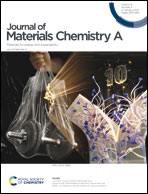A flame-retardant wood-based composite with magnesium–aluminium layered double hydroxides for efficient daytime radiative cooling†
Abstract
Passive daytime radiative cooling (PDRC) is a zero-energy-consumption cooling technology and is very promising for future energy-efficient buildings. Wood-based composites, as conventional green and sustainable building materials, have shown their prominent PDRC capabilities in recent studies. In this context, it is of practical significance to endow these wood-based materials with the additional characteristic of flame resistance while maintaining or even enhancing their PDRC performance, which, however, remains a grand challenge. Herein, we demonstrate the successful incorporation of magnesium–aluminium layered double hydroxide (MgAl-LDH) nanoflakes into delignified wood sawdust (i.e., lignocellulose fibers) by a freeze-drying assisted lamination process for simultaneous PDRC and flame-retardant applications. Due to the interfacial hydrogen bonding between lignocellulose fibers and MgAl-LDH nanoflakes, the composite material delivers an efficient PDRC performance (a cooling effect up to 14 °C under sunlight) as well as excellent flame-retardant properties (a 52.9% reduction in the heat release rate during combustion as compared to natural wood). Such an effective combination of superior PDRC and flame-retardant performance in a wood-based composite can lead to expanding applications of wood derivatives.



 Please wait while we load your content...
Please wait while we load your content...